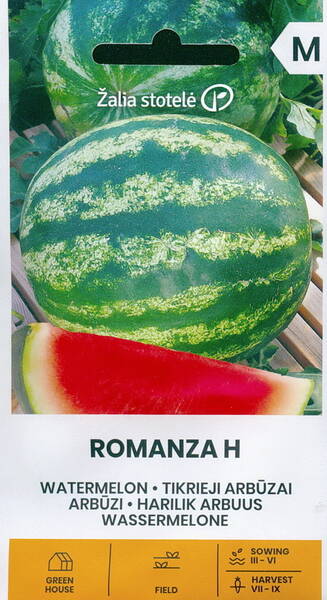Immerse yourself in a world of juicy delight with the Romanza F1 watermelon! This early, high-yielding hybrid of the Crimson Sweet variety will give you an unforgettable taste of summer right at the start of the season. Imagine: a huge, striped beauty radiating a sweet aroma graces your table.
The Romanza F1 watermelon is a guarantee of quality and exceptional flavor. Its round fruits with a thin yet firm skin weigh 7-9 kg. And beneath that skin lies a true treasure— dark red, juicy flesh that melts in your mouth. Even if you're eager to try it and it's not quite ripe, its pink flesh will still delight you with its sweet flavor .
Technical specifications:
- Type: F1 Hybrid
- Variety type: Crimson Sweet
- Ripening period: Early (65-70 days from germination)
- Fruit shape: Round
- Fruit weight: 7-9 kg
- Flesh color: Dark red
- Taste: Sweet, juicy
- Disease Resistance: High resistance to Fusarium wilt and anthracnose
- Transportability: Excellent
For an earlier harvest , it's recommended to grow watermelon from seedlings. This will allow you to enjoy the first fruits several weeks earlier. "Romanza" F1 has excellent shelf life after harvesting —up to 45-65 days, making it ideal for transportation and storage.
The Romanza F1 watermelon grows well in sandy and sandy loam soils . Avoid overly wet soils, as they are unsuitable for growing this crop. Choose a slightly elevated site for planting, one that receives good warmth and sun exposure, and is protected from strong winds. It's important to remember that watermelons can be replanted in the same location no sooner than four years later.
Sow seeds when the soil warms to a depth of 8-10 cm and reaches 15°C. When grown from seedlings, transplant them into the ground when the danger of frost has passed, when they have 3-4 true leaves. The recommended planting pattern in open ground is 140x100 cm, and in greenhouses, 70x70 cm using trellises.
Please note: The seeds are already disinfected with Fludioxonil. This ensures reliable protection against diseases during the initial growth stage.
* It’s unlikely that there’s a person who would say that they don’t like watermelons...
This giant berry has become a favorite among everyone. During the harvest season, many even use a watermelon diet to cleanse the kidneys and urinary tract, which is truly effective. But few people know that this fruit has other healing properties as well.
For example, it's rich in iron, which helps with anemia. Its high content of easily digestible sugars makes it beneficial for diabetes. For the treatment of liver and gallbladder diseases, including cirrhosis, Botkin's disease, atherosclerosis, hypertension, gout, gastritis, constipation, arrhythmia, coronary insufficiency, tonsillitis, obesity, and various intoxications, it is recommended to include 2-2.5 kg of fresh watermelon pulp in the daily diet.
For general body cleansing, unless contraindicated, a watermelon fast is used, whereby only watermelon and rye bread are consumed for 3-4 days. Intensive urine flow during these days flushes the kidneys and urinary tract, removing sand and small stones.
Watermelon's rind, along with its seeds and rind, is not the only part of the fruit that has medicinal properties. These can be preserved for future use and used for the same ailments as the rind, in the form of decoctions and infusions. For gastritis, for example, 100 grams of dried rind should be steeped in 0.5 liters of boiling water until completely cool. This is best done in a thermos. Adults weighing 70-75 kg are recommended to take 100-125 ml of the infusion 4-6 times daily. For children, the dosage should be reduced proportionally to the child's weight.
For gallstones and to cleanse the bile ducts, pour 150-170 g of dried bark into a liter of boiling water, place over low heat, and simmer for 25-30 minutes. Take 200 ml of the decoction before meals 3-5 times daily.
Consumption of watermelon pulp in large quantities is contraindicated in cases of renal failure, exacerbation of gastric ulcers, and duodenal ulcers.












